Birds are amazing creatures that come in all sorts of colors and shapes. However, only a few bird species are as special and eye-catching as gray birds with red heads. When you see these birds, it’s hard not to stop and admire their stunning looks.
In this blog post, we’ll take a closer look at these gray birds with red heads. We’ll learn about what makes them unique, where they live, and what they like to eat. So, let’s spread our wings and dive into the colorful world of gray birds with red heads!
List of 15 Gray Birds with Red Heads
Alor Myzomela

- Scientific name: Myzomela prawiradilagae
- Lifespan: Information not readily available, but it can vary among species.
- Wingspan: Information not readily available.
- Native to: Alor Island in Indonesia.
The Alor Myzomela is a small and striking bird species found in the Alor Archipelago in Indonesia. Adult Alor Myzomelas have bright and contrasting plumage with predominantly scarlet-red feathers on their heads, throats, and upperparts, and contrasting black wings and tail. They have a distinctive black mask around their eyes.
These myzomelas are often found in various habitats in the Alor Archipelago, including forests, gardens, and coastal areas. They primarily feed on nectar from flowers, as well as insects and other small invertebrates.
Alor Myzomelas are appreciated for their vibrant colors, especially the males, and their association with the unique ecosystems of the Alor Archipelago. They are known for their high-pitched, melodious calls and are a charismatic bird species in their range.
Red-crested Cardinal

Image Source
- Scientific name: Paroaria coronata
- Lifespan: Up to 10 years
- Size: Approximately 17-20 centimeters (6.7-7.9 inches)
- Origin: South America (native to Argentina, Bolivia, Brazil, and Paraguay)
The Red-crested Cardinal is a medium-sized songbird found in South America, particularly in countries like Brazil, Argentina, and Paraguay. Adult Red-crested Cardinals have a striking appearance with a bright red crest, forehead, and throat. They have white underparts, black markings around their eyes and wings, and a grayish back.
These cardinals are often found in various habitats, including grasslands, forests, and urban areas. They are omnivorous, feeding on a diet of seeds, fruits, insects, and other small invertebrates.
Red-crested Cardinals are appreciated for their vibrant plumage, especially the striking red crest, which makes them stand out in their habitat. They are also known for their melodious and musical songs, which are often heard during the breeding season. They are a familiar and colorful bird species in South America.
Red-headed Finch

- Scientific name: Amadina erythrocephala
- Lifespan: Typically 5-7 years
- Size: Small finch; around 4-5 inches (10-13 cm) in length
- Origin: Native to sub-Saharan Africa
The Red-headed Finch also known as the Paradise Finch, is a small and colorful bird species found in southern Africa, particularly in regions such as South Africa, Namibia, and Botswana. Adult Red-headed Finches have a striking appearance with bright red plumage on their heads and throats, a black face mask, and brownish-gray bodies.
These finches are often found in a variety of open habitats, including grasslands, savannas, and agricultural areas. They primarily feed on a diet of seeds, grasses, and small invertebrates.
Red-headed Finches are appreciated for their vibrant colors, especially the males during the breeding season when their red plumage is most intense. They are often seen in flocks, and their cheerful and musical calls are a characteristic sound in their habitat. They are a charismatic and popular bird species in southern Africa.
Red-headed Myzomela
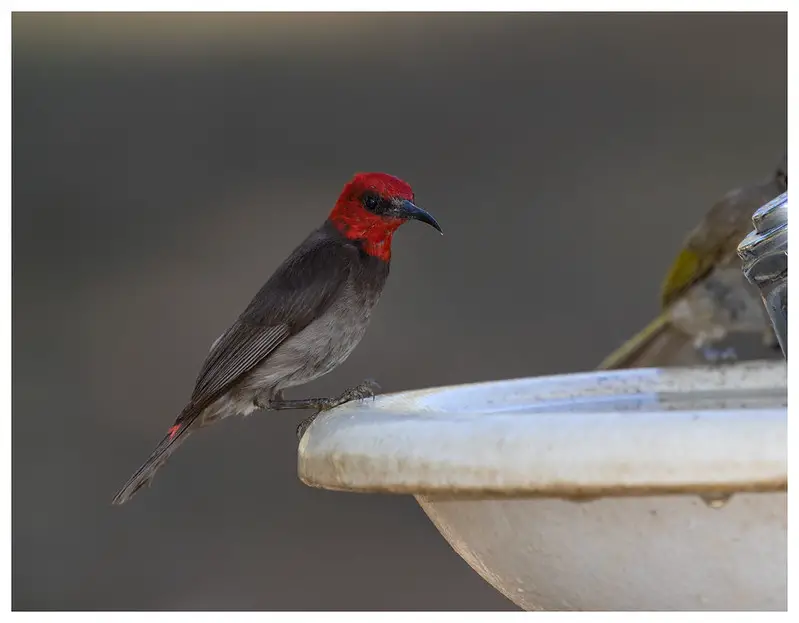
Image Source
- Scientific name: Myzomela erythrocephala
- Size: Approximately 11-12 centimeters (4.5-5 inches)
- Origin: Australia and Papua New Guinea
The Red-headed Myzomela is a small and colorful bird species found in parts of Southeast Asia and the western Pacific. Adult male Red-headed Myzomelas have a striking appearance with bright red plumage on their heads, throats, and upperparts, contrasting with black wings and tails. They have a white belly and a black mask around their eyes.
These myzomelas are often found in various habitats, including forests, gardens, and coastal areas. They primarily feed on nectar from flowers, as well as insects and other small invertebrates.
Red-headed Myzomelas are appreciated for their vibrant colors, especially the males, and their association with tropical and subtropical ecosystems in their range. They are known for their high-pitched and melodious calls, which they use for communication and during courtship displays.
Pine Grosbeak

Image Source
- Scientific name: Pinicola enucleator
- Life span: Up to 10 years
- Size: 22-24 cm (8.7-9.4 in)
- Weight: 40-80 g
- Origin: Northern North America and Eurasia
The Pine Grosbeak is a medium-sized finch found in northern parts of North America, Europe, and Asia. Adult male Pine Grosbeaks have a distinctive appearance with a bright red plumage, often described as “rose-red” or “pinkish-red.” They have a thick bill and black wings with white wing bars.
These grosbeaks are often found in coniferous and mixed woodlands, especially in boreal forests. They primarily feed on a diet of seeds, fruits, and buds, including those from pine trees, which give them their name.
Pine Grosbeaks are appreciated for their striking and colorful plumage, especially the males. They are often seen in small flocks during the non-breeding season, and their melodious and warbling calls are a familiar sound in their northern habitats.
Redhead (Large Gray Birds with red Heads)
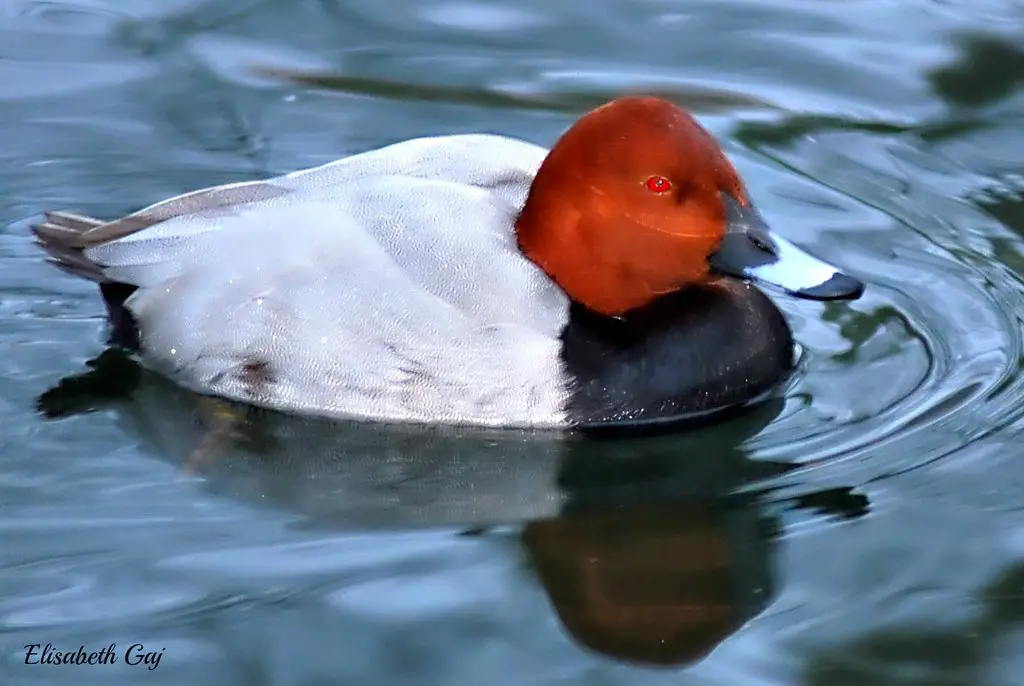
- Scientific name: Aythya americana
- Lifespan: Approximately 6 to 9 years.
- Wingspan: About 74 to 84 cm (29.1 to 33.1 inches).
- Native to: North America
The Redhead is a medium-sized diving duck found in North America. Adult male Redheads have a distinctive appearance with a cinnamon-red head, a black chest, and a gray body. They also have striking yellow eyes. Females, in contrast, have a mottled brown plumage.
These ducks are often found in freshwater habitats such as lakes, ponds, and marshes. They are skilled divers and feed primarily on aquatic plants, seeds, and invertebrates.
Redheads are appreciated for their striking and colorful plumage, especially the males. They are often seen in flocks during the non-breeding season and are known for their low, grunting calls. They are a common sight in wetland areas throughout North America.
Banda Myzomela
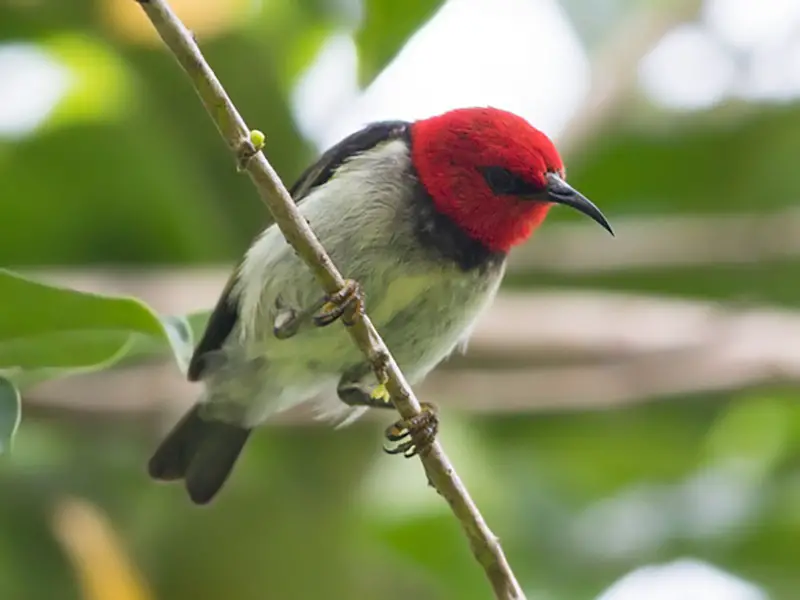
- Scientific name: Myzomela boiei
- Native to: Banda Islands in Indonesia.
The Banda Myzomela is a small and colorful bird species found in the Banda Sea region of Indonesia. Adult male Banda Myzomelas have a striking appearance with bright red plumage on their heads, throats, and upperparts, contrasting with black wings and tails. They have a white belly.
These myzomelas are often found in various habitats on the Banda Islands, including forests, gardens, and coastal areas. They primarily feed on nectar from flowers, as well as insects and other small invertebrates.
Banda Myzomelas are appreciated for their vibrant colors, especially the males, and their association with the unique ecosystems of the Banda Sea region. They are known for their high-pitched, melodious calls and are a charismatic bird species in their range.
Crimson-browed Finch (Small Gray Birds with red Heads)
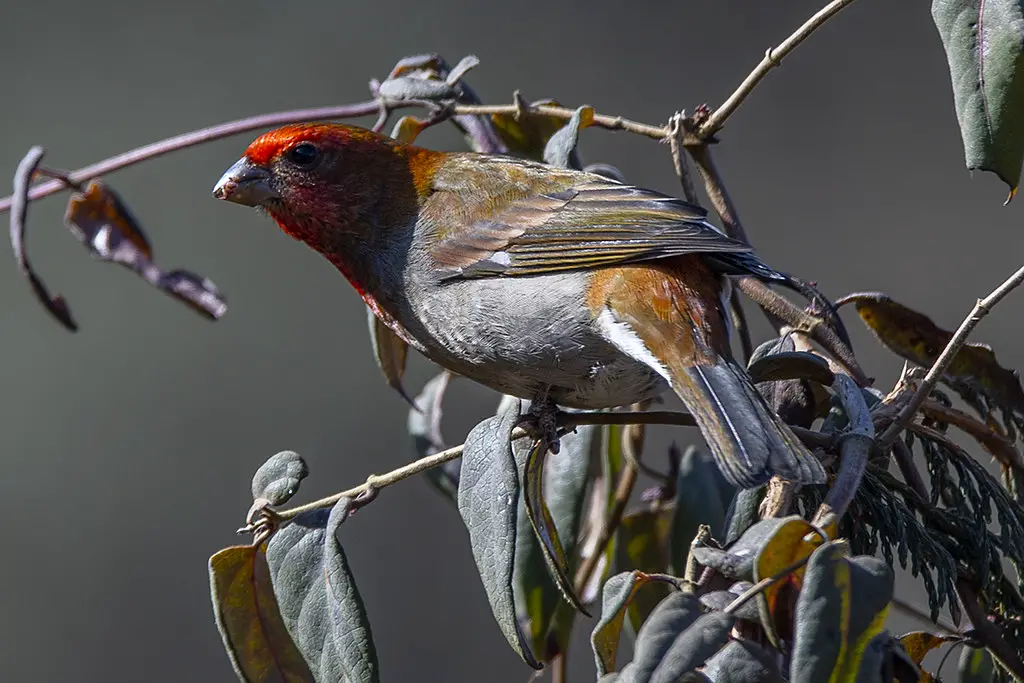
- Scientific name: Neochmia temporalis
- Lifespan: Around 2 to 5 years.
- Wingspan: Approximately 20 cm (7.9 inches).
- Native to: Eastern and southern Australia.
The Crimson-browed Finch is a small and striking bird species native to eastern Australia. Adult Crimson-browed Finches have a distinctive appearance with a bright crimson-red crown and brow, contrasting with white cheeks and underparts, and a brownish-black back and wings. They have a short, pointed bill.
These finches are often found in a variety of habitats, including woodlands, grasslands, and gardens. They primarily feed on a diet of seeds and grains.
Crimson-browed Finches are appreciated for their vibrant colors, especially the crimson-red brow, which makes them stand out in their habitat. They are often seen in small flocks and are known for their melodious and musical calls. They are a charismatic and popular bird species in eastern Australia.
Gang-gang Cockatoo

Image Source
- Scientific name: Callocephalon fimbriatum
- Lifespan: Up to 40 years
- Size: Approximately 35-40 centimeters (14-16 inches)
- Origin: Australia (native to southeastern Australia)
The Gang-gang Cockatoo is a distinctive cockatoo species found in parts of Australia, primarily in the southeastern regions. Adult male Gang-gang Cockatoos have a unique appearance with a mostly slate-gray body, a crest on their head, and a bright red head and crest in males. Females, in contrast, have predominantly gray plumage without the striking red coloration.
These cockatoos are often found in various forested habitats, including eucalyptus woodlands and montane forests. They are known for their feeding habits, which include a diet of seeds, nuts, and various tree fruits.
Gang-gang Cockatoos are appreciated for their unique and visually striking appearance, especially the males with their red head and crest. They are often heard before they are seen, as their calls include soft “creaky gate” sounds. They are considered a charismatic and iconic bird species in southeastern Australia.
Crimson Sunbird
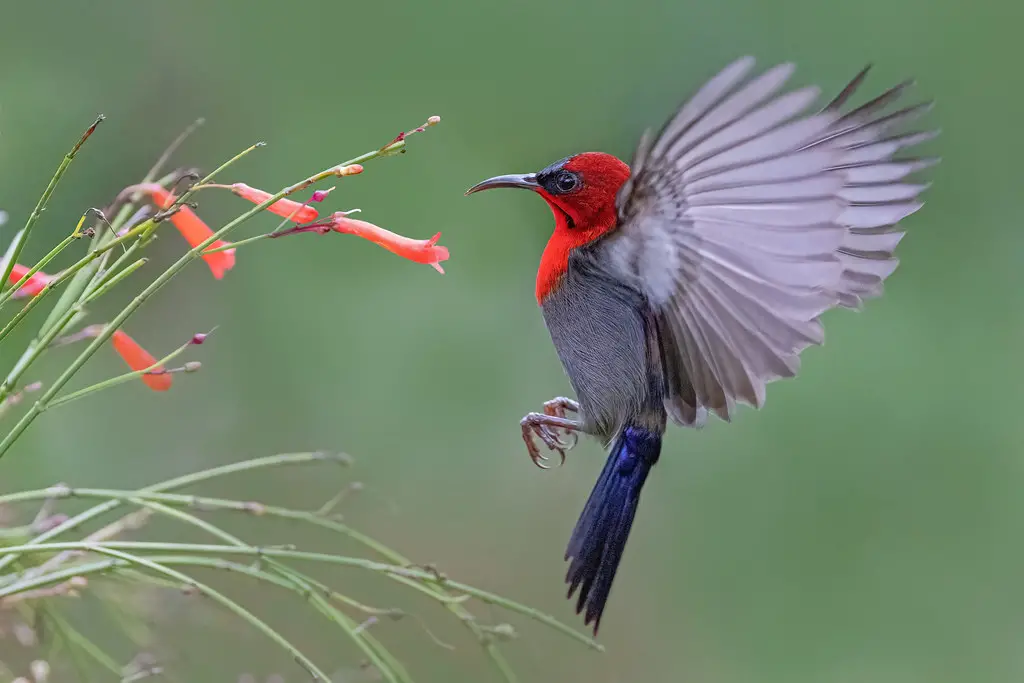
- Scientific name: Aethopyga siparaja
- Native to: South and Southeast Asia.
The Crimson Sunbird is another beautiful bird in our list of gray birds with red heads. It is a small and colorful bird species found in parts of Asia, including Southeast Asia and the Indian subcontinent. Adult male Crimson Sunbirds have a striking appearance with predominantly crimson-red plumage, glossy black wings, and a metallic green-blue crown. Females, on the other hand, have more subdued olive-brown plumage.
These sunbirds are often found in a variety of habitats, including gardens, forests, and flowering shrubs. They are nectar feeders and primarily feed on the nectar of various flowers, often hovering to access the nectar with their specialized bills. They also consume insects and spiders for protein.
Crimson Sunbirds are appreciated for their vibrant and iridescent plumage, especially the males. They are agile fliers and are known for their melodious and sweet calls. They are often associated with gardens and areas with blooming flowers and are considered charismatic and attractive bird species in their range.
Desert Cardinal

Image Source
- Scientific name: Cardinalis sinuatus
- Life span: Up to 10 years
- Size: 20-23 cm (7.9-9.1 in)
- Weight: 42-50 g
- Origin: Southwestern United States and Mexico
The Desert Cardinal is a bird species found in the southwestern United States and parts of Mexico. It is closely related to the Northern Cardinal but is adapted to arid and desert habitats. Adult male Desert Cardinals have a distinctive appearance with bright red plumage on their heads, throats, and underparts, contrasting with a grayish-brown back and wings. Females have a more subdued plumage with brownish tones.
These cardinals are often found in desert scrubland, arid canyons, and desert oases. They primarily feed on a diet of seeds, fruits, insects, and other small invertebrates.
Desert Cardinals are appreciated for their striking colors, especially the males, and their adaptation to harsh desert environments. They are often heard singing their melodious and whistling calls, which are familiar sounds in the desert regions they inhabit. They are a symbol of resilience in arid landscapes.
Red-bellied Woodpecker

- Scientific name: Melanerpes carolinus
- Lifespan: Around 2 to 3 years in the wild.
- Wingspan: Approximately 38 to 45 cm (15 to 17.7 inches).
- Native to: Eastern United States.
The Red-bellied Woodpecker is a medium-sized woodpecker species found in eastern North America. Despite its name, the “red belly” of this woodpecker is actually a pale pinkish-red patch on its lower belly, which is often not visible during casual observation. Adult Red-bellied Woodpeckers have a striking appearance with black and white plumage on their wings and back, a red crown on their head, and a black-and-white striped face.
These woodpeckers are often found in a variety of habitats, including woodlands, forests, suburban areas, and parks. They are omnivorous, feeding on a diet that includes insects, spiders, tree sap, fruits, and seeds. They are also known to store food in tree crevices for later consumption.
Red-bellied Woodpeckers are appreciated for their vibrant appearance, especially the red crown on males, and their characteristic “chur-chur-chur” calls. They are often seen clinging to tree trunks and branches while foraging for insects or drumming on trees as part of their communication and territory establishment.
Red-breasted Sapsucker
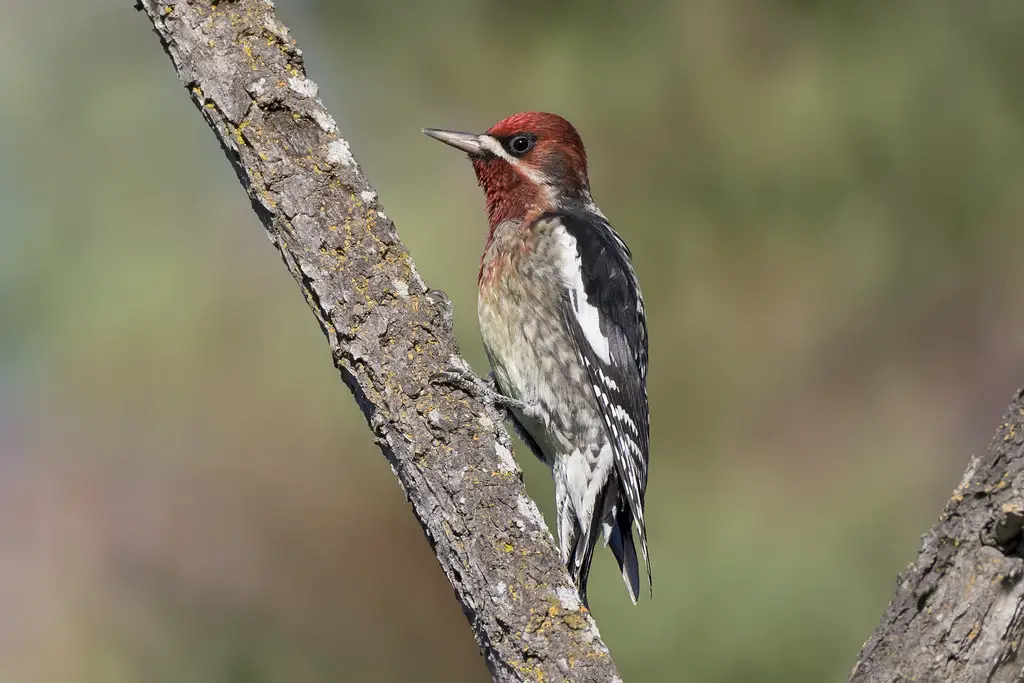
- Scientific name: Sphyrapicus ruber
- Lifespan: Information not readily available.
- Wingspan: Information not readily available.
- Native to: Western North America
The Red-breasted Sapsucker is a medium-sized woodpecker species found in North America’s western regions, primarily in the Pacific Northwest and parts of western Canada and the United States. Adult Red-breasted Sapsuckers have a distinctive appearance with black and white plumage on their wings and back, a red crown on their head, and a prominent red throat and breast.
These sapsuckers are often found in coniferous and mixed woodlands, particularly where there are stands of birch and maple trees. They are named for their feeding behavior, as they drill small holes in tree bark to access sap. They also consume insects attracted to the sap and feed on other small invertebrates.
Red-breasted Sapsuckers are appreciated for their striking appearance, especially the red throat and breast, and their unique feeding habits. They are often heard making a series of mewing and whinnying calls. These sapsuckers are associated with certain tree species that produce sap, and their activities can create distinctive rows of sap wells on tree trunks.
Yellow-Bellied Sapsucker

Image Source
- Scientific name: Sphyrapicus varius
- Lifespan: Up to 9 years
- Size: Approximately 19-22 cm (7.5-8.5 inches)
- Native to: North America
The Yellow-Bellied Sapsucker is a woodpecker species native to North America. This unique bird can be recognized by its black and white striped feathers, with a yellow belly and red crown on males. Females have a white neck and a less noticeable red crown, while both genders show white wing spots and straight white lines on their wings.
Measuring about 7-8 inches (18-20 centimeters) in length, the Yellow-Bellied Sapsucker uses different wooded areas, including deciduous and mixed woods, as well as trees near water sources throughout its range.
Notably, the Yellow-Bellied Sapsucker is known for its eating habits. It makes rows of small holes in tree bark, especially in deciduous trees, to feed on the sap that runs from the holes. Insects drawn to the sap, as well as sweets and berries, also make up part of their food.
During the spring and summer, the female builds a nest hole in a tree, where she lays 4-6 white eggs. Both parents share brooding chores and care for the hatchlings.
Scarlet Myzomela

- Scientific name: Myzomela sanguinolenta
- Native to: Northern and Eastern Australia, as well as parts of New Guinea and nearby islands.
The Scarlet Myzomela is a captivating bird species that belongs to the honeyeater family, Meliphagidae. These small passerine birds are native to various regions of Australasia, including Australia, Indonesia, Papua New Guinea, and nearby islands.
The name “Scarlet” aptly describes their striking appearance. Male Scarlet Myzomelas are adorned with vibrant scarlet plumage, which covers their entire body, except for their black wings and tail. In contrast, females exhibit a more subdued appearance, featuring olive-green to brownish-gray plumage with a hint of scarlet on their throat and belly.
These birds are known for their nectar-feeding habits, and they play a crucial role in pollination within their ecosystems. They use their specialized, brush-tipped tongues to extract nectar from flowers. In addition to nectar, Scarlet Myzomelas also feed on insects and spiders, making their diet diverse.
Scarlet Myzomelas are often found in a variety of habitats, including tropical rainforests, woodlands, coastal areas, and even gardens with flowering plants. Their vibrant colors and active foraging behavior make them a delight for birdwatchers and nature enthusiasts.
Final Thoughts on Gray Birds with Red Heads
As we come to the end of our journey into the world of gray birds with red heads, one thing is abundantly clear: nature is a masterful artist. These birds, with their gray plumage and striking red crowns, serve as living canvases, showcasing the beauty and diversity of life on our planet.
Through our exploration, we’ve discovered that these birds are not just visually striking but also incredibly fascinating in their habits and habitats. They teach us that even in the most subtle and unassuming of creatures, there exists a world of wonder waiting to be uncovered.
Further Readings
- Gray Birds in North America
- Black Birds with Gray Heads
- Gray Birds with Yellow Bellies
- Gray Birds with White Bellies
List of Gray Birds with Red Heads
- Alor Myzomela
- Red-crested Cardinal
- Red-Headed Finch (Paradise Finch)
- Red-headed Myzomela
- Pine Grosbeak
- Redhead
- Banda Myzomela
- Crimson-browed Finch
- Gang-gang Cockatoo
- Crimson Sunbird
- Desert Cardinal
- Red-bellied Woodpecker
- Red-breasted Sapsucker
- Yellow-Bellied Sapsucker
- Scarlet Myzomela


![23 Beautiful Grey Birds in North America [Images + IDs]](https://birdsology.com/wp-content/uploads/2023/06/4781582316_225694b7d8_b-600x400.jpg)
![Gray Birds with White Bellies [Beauty in Subtle Contrasts]](https://birdsology.com/wp-content/uploads/2023/05/european-crested-tit-7677811_128-600x400.jpg)